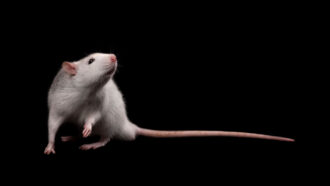Baby’s stress can last decades
Early stress may impair adult behavior, especially in girls

The first year is a big one for babies: Everything is new. Infants pick up a lot of information that will be useful throughout their lives. What happens then and on into the preschool years sets the stage for behavior in the years to come.
A new study now finds that young children who started life in rough, stressful situations showed signs of anxiety as teens. Their brains also behaved differently from those of teens who felt more secure during their early childhood.
Anxiety is a feeling of worry. (You may feel anxious about an upcoming game, for example, or how you did on a difficult test.) Your brain has ways to deal with anxiety, but that coping ability may not work as well in the brains of people who had a stressful start.
Other studies have shown that early negative experiences in animals can shape their brains and behavior when older. But making the same connection in people has been difficult for scientists.
The new study shows just such a link. (It doesn’t prove that stress causes the later anxiety, but it does point to a connection that scientists will try to understand.) It may help researchers identify how bad experiences can permanently alter the human brain.
Cory Burghy studies behavior and the brain at the University of Wisconsin–Madison. She led the new study, which was published in November. She and her collaborators studied data on children, collected at various times during the participants’ lives.
Mothers provided the first set of data during their infants’ first year. At three different times that year, those moms described any stressful situations they had at home, like trouble with money or relationships.
The youngsters’ spit, sampled 4.5 years later, provided a second set of data. Among girls whose moms had reported stress during a baby’s first year, these saliva samples had high levels of a hormone called cortisol. A hormone is a chemical that tells cells or tissues to do something, and the body releases the hormone cortisol in response to stress. The scientists did not find the same cortisol spike in boys’ saliva.
Brain scans performed at age 18 also showed differences if a girl’s preschool-age saliva had showed high stress-hormone levels. Two brain parts usually collaborate to help a person deal with negative emotions. But in the girls who’d had high levels of cortisol as children, these two brain regions — called the prefontal cortex and the amygdala — failed to coordinate.
And girls with weaker connections between the two brain regions had more problems with anxiety than girls with stronger connections. (Although some anxiety is normal, high levels can interfere with normal life.) Burghy’s team doesn’t know why boys didn’t show the same problem.
The new data hint at long-term effects of a troubling home environment, says Rasmus Birn, a brain-scanning expert on the new study. He says those scans provide “a snapshot” of how the brain responds to early life stress.
Power Words
anxiety A feeling of worry, nervousness or unease, typically about an upcoming event or something with an uncertain outcome.
cortisol A hormone produced by the outer portion of the adrenal gland (next to each kidney) and released during times of stress.
hormone A substance produced in an organism and transported in tissue fluids such as blood to stimulate specific cells or tissues into action.
amygdala A roughly almond-shaped mass of gray matter deep inside each half of the brain.







